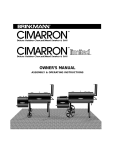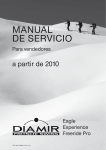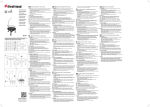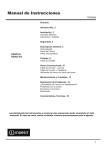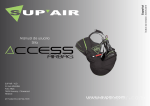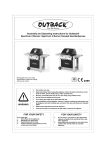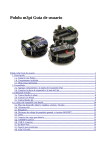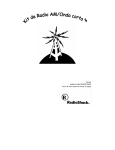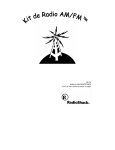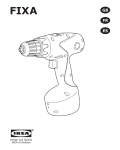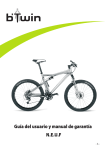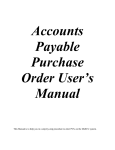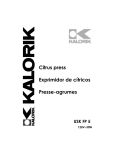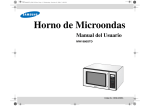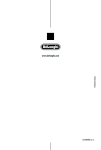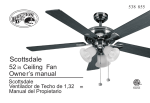Download KLASEN
Transcript
KLASEN 202-544-30 Design and Quality IKEA of Sweden DANGER: If you smell gas: 1.Shut off gas to the barbecue 2.Extinguish any open flame 3.Open lid 4.If the odour continues, keep away from the barbecue and immediately call your gas supplier or the fire department WARNING: Do not store or use gasoline or other flammable liquids or vapours in the vicinity of this or any other appliance A LP cylinder not connected for use shall not be stored in the vicinity of this or any other appliance PELIGRO: Si huele a gas: 1.Desconecta el gas de la barbacoa 2.Extingue las llamas directas 3.Abre la tapa 4.Si el olor persiste, aléjate de la barbacoa y llama a tu proveedor de bombonas de gas o a los bomberos. ADVERTENCIA: No guardes ni uses gasolina u otros líquidos o vapores inflamables cerca de este o cualquier otro aparato. No guardes las bombonas de gas sin conectar cerca de la barbacoa u otros aparatos. ENGLISH4 ESPAÑOL12 ENGLISH 4 KLASEN gas barbecue WARNING For outdoor use only. Read these instructions before using the barbecue. Failure to follow these instructions and safety warnings may result in serious bodily injury or death, and/or property loss. Warning: accessible parts may be very hot. Keep children and pets away from the barbecue. Do not attempt to move the barbecue during use. Turn off the gas supply at the gas cylinder after use. Any modification of the barbecue, misuse, or failure to follow the instructions may be dangerous and cause harm to you or others. Leak test the barbecue before first use, annually, when dismantled, when parts are replaced, or if the gas cylinder is removed or replaced Retain these instructions for future reference. Safety symbols The safety symbols and their meanings are explained below. Read and follow the instructions in this manual carefully. 5 WARNING Failure to read and follow these instructions could result in serious injury or damage to property. Installation must conform with local codes or in absence of a local code with either the National fuel code CSA b149.1 or propane storage and handling code B149. This product is for OUTDOOR USE ONLY. NEVER use in an enclosed space such as a carport, garage, veranda, covered patio, or under an overhead structure of any kind. Important – LEAK TEST THE BARBECUE WHEN FULLY ASSEMBLED BEFORE FIRST USE. IN ADDITION always leak test the barbecue annually, when dismantled, when parts are replaced, or if the gas cylinder is removed or replaced. FAILURE TO DO THIS COULD CAUSE SERIOUS INJURY, OR DAMAGE TO THE BARBECUE. Always keep the cylinder vertical. Important – Ensure the barbecue is positioned on flat, level ground to aid with fat/grease run off. KLASEN gas barbecue is designed for use with liquid propane (LP) gas only. Do not use with natural (piped in city) gas. The valves, orifices, hose and regulator are for LP gas only. This barbecue has been supplied with a propane regulator (only use with propane gas). Should you need to change the gas cylinder, make sure the barbecue is switched off, and that there are no sources of ignition (cigarettes, open flame, sparks, etc.) nearby before proceeding. Never use indoors, in an enclosed area or below ground level. This barbecue shall only be used above ground in an open-air situation with natural ventilation, without enclosed areas, where gas leakage and products of combustion are rapidly dispersed by wind and natural convection. This barbecue is not intended to be used in or on boats or in or on recreational vehicles. This barbecue should not be used under overhead combustible construction. Never use an adjustable regulator with this barbecue. This barbecue will become very hot when in use – take care when touching. Keep children and pets at a safe distance from this barbecue when in use. Do not attempt to move this barbecue when in use. Always turn off gas supply at the gas cylinder when not in use. Any modification of this barbecue may be dangerous. Do not leave this barbecue unattended when in use. Any parts sealed by the manufacturer or his agent must not be altered by the user. When igniting, always have the lid open. Only use the barbecue on a flat, level non-flammable surface or ground. When positioning, ensure the barbecue is a minimum of 1 metre (39") from flammable items or structure. This barbecue is not intended for use with charcoal or other similar fuel. Do not use petrol, white spirit, lighter fluid, alcohol or other similar chemicals to ignite a barbecue. When storing the barbecue or gas cylinder, ensure they are away from flammable materials or liquids. The gas cylinder must not be stored next to this or any other appliance. Always follow care and maintenance instructions – regularly maintain your barbecue. Do not allow grease, fat or food residue to build up in or on the barbecue – RISK OF FIRE. Always replace worn parts – do not use the barbecue if a leak, wear or damage is found. Never overload the grill with food – evenly space over the cooking grill surface, ensuring sufficient air circulation to the burners. Do not store or cover the barbecue until fully cooled. This product is not suitable for lava rocks. Do not obstruct the flow of combustion and ventilation air. 6 Keep the ventilation opening of the cylinder enclosure free and clear from debris. Keep the area around your gas barbecue clear of any combustible materials, petrol or other flammable liquids and vapours. Pressure regulator and hose assembly supplied with this barbecue must be used. Replacement pressure regulators and hose assemblies must be the same as those supplied originally with the barbecue. Never use an adjustable regulator with this barbecue. Do not hang any combustible materials from the hand rails of this barbecue. Accessible parts may be very hot. Keep young children away. Always wear protective gloves or a barbecue mitt when handling hot components or items such as pots. Leak Tests •• IMPORTANT – PERFORM LEAK TESTS BEFORE USE •• Always leak test the unit – annually, when dismantled, when parts are replaced, or if the gas cylinder is removed or replaced. •• Never use an open flame to check for leaks at anytime. DO NOT IGNITE THE BARBECUE DURING LEAK TESTING. •• To be performed in a well-ventilated area. •• Be sure all control knobs are in the ‘OFF’ position. •• Check for leaks by brushing a solution of 1/2 water and 1/2 soap over all the gas system joints, including all valve connections, hose connections and regulator connections. •• Ensure the soap solution has been applied to all connections – connect the regulator to the gas cylinder, open the gas control valve on the regulator allowing gas to flow. •• OBSERVE – if bubbles form over any part of the joints there is a leak. •• Turn off the gas and tighten all joints •• Repeat test. If bubbles form again, do not use the barbecue. Please contact your local dealer for assistance. Gas and Regulator •• The cylinder should be positioned underneath the main barbecue body and stored upright. •• Gas cylinders should never be stored or laid on their side. User Instructions •• Before assembling your barbecue, remove all protective packaging from each part. •• The gas cylinder must have a connection compatible with the regulator supplied with the barbecue and have a minimum capacity of 4kg / 9lbs. •• Do not store a spare LP gas cylinder under or near this appliance. •• Never fill the cylinder beyond 80% full. Failure to follow these instructions exactly may result in fire causing serious injury or death. •• Place dust cap on cylinder valve outlet whenever the cylinder is not in use. Only install the type of dust cap on the cylinder valve outlet that is provided with the cylinder valve. Other types of caps or plugs may result in leakage of propane. Connecting to the Cylinder •• Confirm all barbecue control knobs are in the ‘OFF’ position. •• Connect the regulator to the gas cylinder, hand-tighten it securely (*) and proceed according to the accompanying assembly instructions and the instructions from the gas cylinder supplier. Cylinders used in USA or Canada •• Are only acceptable for use with the appliance provided they are compatible with appliance gas cylinder retention means. See illustration within this user manual depicting correct gas cylinder retention. 7 •• Must be constructed and marked in accordance with Specifications for LP Gas Cylinders of the US Dept of Transportation or the National Standard of Canada CAN/ CSA-B339, cylinders, spheres and tubes for Transportation of dangerous goods. •• Cylinders must have a listed overfilling prevention device. •• Cylinder used must have a collar to protect the cylinder valve. •• Must be a 20lb (9kg) cylinder LPG capacity 4.7 gallons (17.8 litres). Cylinder dimensions: Height 17.75 inches (451mm) and width 12.25 inches (311mm). for leaks before lighting appliance. •• NEVER TEST WITH OPEN FLAME! •• IF YOU SMELL GAS OR A LEAK IS FOUND: —— SHUT OFF GAS AT THE TANK VALVE IMMEDIATELY. —— EXTINGUISH ANY OPEN FLAME, OR OTHER POTENTIAL IGNITION SOURCE. —— DO NOT USE APPLIANCE UNTIL REPAIRS ARE MADE BY QUALIFIED LP GAS DEALER. —— DO NOT ATTEMPT TO MAKE REPAIRS YOURSELF! —— DO NOT USE ANY APPLIANCE, OR PARTS, EXPOSED TO OR DAMAGED BY FIRE! BEFORE USING THIS APPLIANCE: 1. Please read all of these instructions and appliance owners manual prior to installation and use. 8. If not leaking, carefully light appliance and use according to the instructions in this manual. This appliance regulator and tank valve connection may contain two or more important safety features such as Excess Flow Control and High Temperature Activated Shutoff. •• FAILURE TO FOLLOW THESE INSTRUCTIONS MAY RESULT IN AN EXPLOSION OR FIRE THAT MAY CAUSE PROPERTY DAMAGE, SERIOUS INJURY OR DEATH! 2. FOR OUTDOOR USE ONLY! •• Appliance and tank must be in open, well ventilated outdoor area prior to connection end use. Make sure the tank valve is fully closed and not leaking prior to moving or connecting. •• NEVER USE IN A GARAGE OR UNDER OVERHANGS! •• NEVER STORE A SPARE CYLINDER OR ANY FLAMMABLE •• LIQUID OR GAS UNDER OR NEAR THIS APPLIANCE OR •• ANY OTHER HEAT SOURCE. 3. Be sure tank valve and regulator are proper mating types, with correct threads or fittings, see manual. 4. Inspect tank valve, regulator, hose and fittings to be sure they are clean, free or dirt, debris, not plugged and not damaged. If damaged replace before use. See local LP dealer for repairs. 5. Prior to connection, turn all control valves to the OFF position. 6. Connect regulator to tank valve according to appliance owners manual. Handle cylinder with care – the contents are under high pressure. 7. If good connection has been made, slowly open tank valve to full open. Use a soapy water solution to check all gas connections •• NEVER LEAVE THIS APPLIANCE UNATTENDED WHILE IN USE! NOT TO BE USED BY CHILDREN! LIST OF FEATURES The numbering of the product features shown refers to the illustration of the barbecue on the graphic page. Illustration to be on graphic page in the beginning of the manual 1. 2. 3. 4. 5. 6. 7. 8. Handle Hood Cooking grill Burners Vaporizer bars Grease tray Control knobs Barbecue body USER INSTRUCTIONS Before proceeding, make certain that you understand the WARNING statements in this manual. •• Preparation before cooking – To prevent 8 foods from sticking to the cooking grill, please use a long handled brush to apply a light coat of cooking or vegetable oil before each barbecuing session. •• Note: When cooking with your barbecue for the first time, the paint on the outside of the barbecue may change colour slightly as a result of high temperatures. This is normal and should be expected. Lighting the Barbecue •• Open the barbecue hood (2). •• Ensure all knobs are in the ‘OFF’ position (7). •• Turn on the gas supply at the gas cylinder. •• Push control knob (7) down and turn to ignition position. •• Hold control knob in for at least 10 seconds to ensure the burner (4) stays lit. •• If burner does not light after holding dial in for 20 seconds, turn the control knob to the ‘OFF’ position and wait for 1 minute and try again. Do not continuously hold the control knob in as you may cause a build up of gas. •• In windy conditions shield from wind to ensure easy lighting. •• Turn control knob (7) to alter burner settings as required. •• After ignition, the burners should be burned at the high position for 3-5 minutes in order to preheat the barbecue. This process should be done before every cooking session. IMPORTANT - The hood should be open during preheating. •• After completion of preheating, turn burners to low position and cook with the hood in the down position for best cooking results. Manual Lighting Instructions •• Remove the cooking grill (3) and vapour bar (5) from barbecue. •• Place a lit match beside the burner (4) (at the same location as the sparker shield). •• Push and turn the right most control knob (7) anti-clockwise to the high position. •• After successful lighting, light each burner from left to right as desired. •• If burner fails to ignite after repeated attempts, contact the help line number stated in this manual. Grill Cooking The vapour bar evenly distributes the burner flame across the cooking grill area. The natural food juices produced during cooking fall onto the hot vapour bar below and vaporise. Even cooking of food will be achieved by using the barbecue with the hood down. This should only be done with the burner on low. Flare-Up Control IMPORTANT – FLARE UPS CAN OCCUR FROM RESIDUE FAT AND JUICES DRIPPING ONTO THE BURNERS AND HOT VAPOUR BAR. To reduce this, regularly clean the burners and vapour bar. To control flareup, it is advisable to trim away excess fat from meat and poultry before grilling. The burners should always be placed on the low setting during cooking. Always protect your hands when handling anything near cooking surface of the barbecue. Covered Cooking Keep the lid closed when you grill to ensure the heat circulates evenly. With the lid closed, the gas barbeque cooks much like a convection oven. The thermometer in the lid shows what the cooking temperature is inside the barbecue so you don’t have to lift the lid. All preheating and grilling should also be done with the lid closed. Avoid lifting the lid to look inside during the cooking process – heat will be lost. 9 End of Cooking Session After each cooking session, turn the barbecue burners to the ‘HIGH’ position and burn for 5 minutes. This procedure will burn off cooking residue, thus making cleaning easier. Turning Off Your Barbecue Push the control knob (7) in and turn to the ‘OFF’ position. Turn the gas off and disconnect at the cylinder when not in use. The regulator must be disconnected when the barbecue is not in use. Wait until the barbecue is sufficiently cool before closing the hood. FOOD SAFETY Please read and follow this advice when cooking on your barbecue: •• Always wash your hands before and after handling uncooked meat and before eating. •• Always keep raw meat away from cooked meat and other foods. •• Before cooking, ensure barbecue grill surfaces and tools are clean and free of old food residue. •• Do not use the same utensils to handle cooked and uncooked foods. •• Ensure all meat is cooked thoroughly before eating. CAUTION – eating raw or undercooked meat can cause food poisoning •• (e.g bacteria strains such as E.coli) •• To reduce the risk of undercooked meat, cut open to ensure it is cooked all the way through internally. CAUTION – if meat has been cooked sufficiently the meat juices should be clear in colour and there should be no traces of pink/red juice or meat colouring. •• Pre-cooking of larger meat or joints is recommended before finally cooking on your barbecue. •• After cooking on your barbecue always clean the grill cooking surfaces and utensils. CARE AND MAINTENANCE •• Regularly clean your barbecue between uses and especially after extended periods of storage. •• Ensure the barbecue and its components are sufficiently cool before cleaning. •• Do not leave the barbecue exposed to outside weather conditions or stored in damp, moist areas. •• Never douse the barbecue with water when its surfaces are hot. •• Never handle hot parts with unprotected hands. •• In order to extend the life and maintain the condition of your barbecue, we strongly recommend that the unit is covered when left outside for any length of time, especially during the winter months. •• IMPORTANT – We recommend that servicing of this barbecue should be performed either after every 100 hours of use or annually, whichever is achieved soonest. •• Change the flexible tube when the national conditions require it. Caution If you smell gas – turn off the barbecue, extinguish all flames, open the barbecue hood. If the odour continues, immediately contact your gas supplier. In the event of an uncontrollable fire, immediately disconnect the gas cylinder moving it away from fire and contact the fire services. DO NOT PUT YOURSELF AT RISK! Ensure aerosols are not used near this barbecue when in use. Ensure all packaging and plastic bags are disposed of safely. Cooking Grill (3) •• Clean with hot soapy water. •• To remove any food residue, use a mild cream cleaner on a non-abrasive pad. •• Rinse well and dry thoroughly. Burner (4) Maintenance •• In normal usage, burning off the residue after cooking will keep the burners clean. •• The burners should be cleaned annually, or whenever heavy build-up is found, to ensure that there are no signs of blockage (debris, insects) in either the burner portholes or the venturi tubes of the burners fitted over the valve outlets. A blocked burner can lead to a fire beneath the grill. 10 •• Visually inspect the operation of the burners. •• See figure below showing correct burning. There should be flame from all portholes. weather conditions, particularly if you live near coastal areas. Prolonged exposure to sunlight, standing water, sea air/saltwater can all cause damage to your appliance. (A cover may not be sufficient to protect your appliance in some of these situations). •• Cover the burners with aluminium foil in order to prevent insects or other debris from collecting in burner holes. Vapour Bar (5) •• Clean the vapour bar with soap and warm water using a low abrasive cleaning cloth or sponge! Grease Tray (6) •• IMPORTANT – Check and clean the grease tray regularly before every use and replace if necessary. Do not allow the fat residue to build up in the tray. NEVER use without grease tray in position. Barbecue Body (8) •• Regularly remove excess grease or fat from the barbecue body with a soft plastic or wooden scraper. •• It is not necessary to remove all the grease from the body. If you need to clean fully, use hot soapy water and a cloth, or nylon-bristled brush only. •• Remove cooking surfaces and burners before full cleaning. •• Do not immerse the gas controls or manifold in water. •• Check burner operation after carefully refitting into body. Fixings •• All screws and bolts, etc. should be checked and tightened on a regular basis. STORAGE Do not leave your barbecue uncovered when not in use. Store your barbecue in a cool dry place like a shed or garage when not in use to protect against the effects of extreme •• If the barbecue is to be stored indoors, the gas cylinder must be disconnected and left outside. The gas cylinder should always be stored outside, in a dry, wellventilated area, away from any sources of heat or ignition. Do not let children tamper with the cylinder. •• Always inspect the hose for cuts, cracks or excessive wear before use. •• If the hose is damaged or there is excessive abrasion or wear or the hose is cut, it must be replaced with a hose suitable for use with LPG and meet the national standards for the country of use and must be as specified by the manufacturer. The length of the hose shall not exceed 1.5m (59"). Danger – do not put barbecue in storage or travel mode immediately after use. Allow the barbecue to cool to touch before moving or storing. Failure to do so could result in fire resulting in property damage, personal injury or death. TECHNICAL INFORMATION This barbecue is designed for outdoor use only using propane gas. Please read all accompanying documentation carefully. Type of gas: Propane Regulator Pressure: 11” per W.C. Injector Size: 0.033 inches Heat input: 18000Btu Gas consumption: 0.72lbs per hour Countries intended for: U.S.A. 11 HOW TO REACH US IF YOU NEED OUR SERVICE Contact your local IKEA store. You will find the address and phone number in the IKEA catalogue or at www.ikea.com. To ensure that we provide you with the best assistance, please read carefully the Assembly Instructions and/or the User Instruction section of this manual before contacting us. TROUBLESHOOTING Problem Possible Cause Solution Burner will not light using the ignition system LP gas cylinder is empty Replace with full cylinder Faulty regulator Have regulator checked or replace Obstructions in burner Clean burner Obstructions in gas jets or gas hose Clean jets and gas hose Electrode wire is loose Reconnect wire Electrode or wire is damaged Change electrode and wire LP gas cylinder too small Use larger cylinder Obstructions in burner Clean burner Obstructions in gas jets or gas Clean jets and gas hose Windy conditions Use BBQ in a more sheltered position Gas valve jammed Replace gas valve Low flame or flashback (fire in burner tube - a hissing or roaring noise may be heard) Gas valve knob difficult to turn ESPAÑOL 12 Barbacoa de gas KLASEN ADVERTENCIA Solo para exteriores. Lee atentamente las instrucciones antes de utilizar la barbacoa. Sigue las instrucciones y las advertencias de seguridad para no dañar el artículo y evitar lesiones graves o incluso la muerte. Advertencia: las piezas accesibles pueden estar a alta temperatura. No dejes que los niños ni las mascotas se acerquen a la barbacoa. No muevas la barbacoa mientras la estés usando. Desconecta la bombona de gas después de usarla. Cualquier modificación de la barbacoa, mal uso u omisión de las instrucciones puede resultar peligrosa y provocar daños personales y a terceros. Examina la barbacoa en busca de fugas antes de usarla, anualmente, al desmontarla, al cambiar alguna pieza o al sacar o cambiar la bombona de gas. Conserva estas instrucciones para futuras consultas. SÍMBOLOS DE SEGURIDAD A continuación se explica el significado de los símbolos de seguridad. Consulta y sigue atentamente las instrucciones de este manual. PELIGRO PELIGRO: indica una situación de riesgo inminente que, si no se evita, podría provocar daños graves o la muerte. ADVERTENCIA ADVERTENCIA: indica una situación potencialmente peligrosa que, si no se evita, podría provocar daños graves o la muerte. PRECAUCIÓN PRECAUCIÓN: indica una situación potencialmente peligrosa o arriesgada que, si no se evita, podría provocar daños menores o moderados. 13 ADVERTENCIA Consulta y sigue las instrucciones para no dañar el artículo y evitar lesiones graves. La instalación debe ser conforme a la normativa local y en caso de no existir de acuerdo con el código nacional para el fuel CSA b149.1 o el código B149” de manipulación y almacenaje de propano. Este producto SOLO DEBE USARSE EN EL EXTERIOR. NO lo utilices es un espacio cerrado como un garaje, porche, galería, patio cubierto ni bajo ninguna estructura cubierta, sea del tipo que sea. Importante: COMPRUEBA QUE LA BARBACOA NO PRESENTA FUGAS ANTES DE USARLA. Examina TAMBIÉN la barbacoa en busca de fugas anualmente, al desmontarla, al cambiar alguna pieza o al sacar o cambiar la bombona de gas. DE LO CONTRARIO, PUEDES DAÑAR LA BARBACOA O SUFRIR LESIONES GRAVES. Mantén siempre la bombona en posición vertical. Importante: asegúrate de colocar la barbacoa en una superficie plana y uniforme para que resulte más sencillo eliminar la grasa y el aceite. La barbacoa de gas KLASEN solo puede utilizarse con gas propano líquido (LP). No la utilices con gas natural. Las válvulas, las aberturas, la manguera y el regulador solo admiten gas LP. La barbacoa incluye un regulador de propano que solo puede usarse con este gas. Antes de cambiar la bombona de gas, asegúrate de apagar la barbacoa y de que no hay ninguna fuente de ignición cerca (cigarrillos, llama directa, chispas, etc.). No la utilices en el interior, en un espacio cerrado o bajo el nivel del suelo. La barbacoa solo puede usarse sobre el nivel del suelo, en un espacio al aire libre con ventilación natural, sin zonas cerradas, donde las fugas de gas y los productos de la combustión se dispersen rápidamente por medio del viento y la convección natural. La barbacoa no está indicada para barcos ni autocaravanas. La barbacoa no puede usarse bajo una estructura cubierta que sea combustible. No utilices un regulador ajustable con la barbacoa. Durante el uso la barbacoa alcanza altas temperaturas: manipúlala con precaución. Procura que los niños y los animales se mantengan a una distancia prudencial cuando esté encendida. No muevas la barbacoa mientras la estés usando. Desconecta la bombona de gas cuando no se esté utilizando. Modificar la barbacoa puede resultar peligroso. Vigila la barbacoa mientras la estés usando. No alteres las piezas selladas por el fabricante o el distribuidor. Para encenderla, la tapa debe estar levantada. Instala la barbacoa en una superficie plana y nivelada que no sea inflamable. Asegúrate de instalar la barbacoa a 39 pulgadas como mínimo de los artículos u estructuras inflamables. La barbacoa no puede usarse con carbón vegetal ni otro combustible similar. No uses gasolina, aguarrás, líquido para mecheros, alcohol ni otros productos químicos para encender la barbacoa. Cuando guardes la barbacoa o la bombona de gas, asegúrate de que no hay ningún material o líquido inflamable cerca. La bombona de gas no debe guardarse junto a la barbacoa ni otro aparato. Sigue las instrucciones de mantenimiento para conservarla en buen estado. No dejes que se acumule grasa ni restos de comida en la barbacoa, ya que hay RIESGO DE INCENDIO. Sustituye siempre las piezas desgastadas; no uses la barbacoa si presenta una fuga o alguna pieza dañada o desgastada. No sobrecargues de comida la parrilla; reparte los alimentos de manera uniforme por la parrilla para que circule el aire por los quemadores. No guardes ni tapes la barbacoa hasta que se haya enfriado por completo. 14 Este producto no es apto para piedras volcánicas. No obstruyas el conducto de combustible ni la ventilación. Limpia la abertura de ventilación del receptáculo de la bombona para que no se acumulen restos. No dejes materiales combustibles, gasolina u otros líquidos o vapores inflamables cerca de la barbacoa. Utiliza el regulador de presión y la manguera que se suministra con la barbacoa. Los reguladores de presión y las mangueras de repuesto deben ser los mismos que vienen originalmente con la barbacoa. No utilices un regulador ajustable con la barbacoa. No cuelgues materiales combustibles de la barra de soporte de la barbacoa. Las piezas accesibles pueden esta a alta temperatura. No dejes que los niños se acerquen. Lleva siempre manoplas para manipular los utensilios o los instrumentos de cocina, como los cazos, para no quemarte. PRUEBA DE FUGAS •• IMPORTANTE: COMPRUEBA QUE NO PRESENTA FUGAS ANTES DE USARLA •• Examina la barbacoa en busca de fugas anualmente, al desmontarla, al cambiar alguna pieza o al sacar o cambiar la bombona de gas. •• No utilices en ningún caso una llama directa para comprobar si presenta fugas. NO ENCIENDAS LA BARBACOA DURANTE EL PROCESO. •• Este proceso debe realizarse en una zona bien ventilada. •• Comprueba que los mandos están en posición de apagado. •• Comprueba si existe alguna fuga mojando las juntas del sistema de gas con una solución de agua y jabón a partes iguales, incluidas las conexiones de las válvulas, de la manguera y del regulador. •• La solución jabonosa debe aplicarse en todas las conexiones: conecta el regulador a la bombona de gas y abre la válvula de control de gas del regulador para que salga. •• TEN EN CUENTA que si se forman burbujas en alguna de las juntas, es que hay una fuga. •• Apaga el gas y aprieta todas las juntas •• Repite la prueba. Si vuelven a formarse burbujas, no uses la barbacoa. Ponte en contacto con tu distribuidor local para obtener ayuda. Gas y regulador •• Coloca la bombona en posición vertical bajo la estructura principal de la barbacoa. •• No las pongas nunca de costado, ni siquiera al guardarlas. Instrucciones de uso •• Antes de montar la barbacoa, saca los envases protectores de cada pieza. •• La bombona de gas debe presentar una conexión compatible con el regulador suministrado con la barbacoa y tener una capacidad mínima de 4 kg (9 lbs). •• No guardes las bombonas de gas LP de repuesto debajo o cerca de la barbacoa. •• Al rellenar las bombonas, no superes el 80% de su capacidad. De lo contrario, existe un riesgo de incendio que podría provocar lesiones graves e incluso la muerte. •• Tapa la válvula de la bombona cuando no la estés utilizando. Utiliza únicamente el tapón que se suministra con la válvula de la bombona. Si utilizas otros tapones puede producirse una fuga de gas propano. Conectar la bombona •• Comprueba que los mandos de la barbacoa están en posición de apagado. •• Conecta el regulador a la bombona de gas, apriétalo (*) y procede según las instrucciones de montaje que se proporcionan y las instrucciones del proveedor de la bombona. 15 Las bombonas que se usan en EE. UU. o Canadá •• Podrían utilizarse otras bombonas con la barbacoa siempre que sean compatibles con el sistema de retención de las bombonas de gas. Consulta la ilustración que aparece en este manual de uso para ver el sistema de retención correcto de las bombonas de gas. •• Deben fabricarse y etiquetarse según las especificaciones para las bombonas de gas LP del Departamento de Transporte estadounidense o el estándar nacional canadiense CAN/CSA-B339, sobre bombonas, esferas y mangueras para transportar mercancías peligrosas. •• Las bombonas deben presentar un dispositivo homologado para evitar llenarlas demasiado. •• Las bombonas deben presentar un manguito para proteger la válvula. •• Deben ser bombonas GLP de 9 kg (20 lb) y tener una capacidad de 17,8 litros (4.7lbs). Dimensiones de la bombona: 45,1 cm (17.75") (alto) x 31,1 cm (12.25") (ancho). ANTES DE USAR LA BARBACOA: 1. Consulta estas instrucciones y el manual de usuario de la barbacoa antes de instalarla y usarla. 2. SOLO PARA USO EN EXTERIORES. •• El aparato y la bombona deben guardarse en una zona exterior bien ventilada antes de conectarse. Comprueba que la válvula de la bombona está totalmente cerrada y que no presenta fugas antes de moverla o conectarla. •• NO LA USES EN UN GARAJE NI BAJO TECHO. •• NO GUARDES LAS BOMBONAS DE REPUESTO NI LOS LÍQUIDOS O GASES INFLAMABLES DEBAJO O CERCA DE LA BARBACOA U OTRAS FUENTES DE CALOR. 3. Comprueba que la válvula y el regulador de la bombona coinciden y las roscas y demás accesorios de montaje encajan. Consulta el manual. 4. Comprueba que la válvula de la bombona, el regulador, la manguera y demás accesorios de montaje están limpios y no presentan restos de suciedad, y que no están conectados ni dañados. Si están dañados, cámbialos antes de usarlos. •• Consulta a tu distribuidor de gas local para reparaciones. 5. Antes de realizar las conexiones gira todos los mandos a la posición de apagado. 6. Conecta el regulador a la válvula de la bombona siguiendo el manual de usuario de la barbacoa. Maneja la bombona con precaución: el contenido está a alta presión. 7. Si la conexión se ha hecho correctamente, abre poco a poco la válvula de la bombona hasta abrirla del todo. Comprueba que no hay fugas aplicando solución jabonosa en las conexiones antes de encender la barbacoa. •• NO BUSQUES FUGAS CON UNA LLAMA DIRECTA •• SI HUELE A GAS O ENCUENTRAS UNA FUGA: —— DESCONECTA EL GAS INMEDIATAMENTE. —— APAGA CUALQUIER LLAMA DIRECTA U OTRA POSIBLE FUENTE DE IGNICIÓN. —— NO USES EL APARATO ANTES DE QUE UN PROVEEDOR CUALIFICADO HAYA REALIZADO LAS CONEXIONES DE GAS. —— NO INTENTES REPARAR EL APARATO TÚ MISMO. —— NO USES NINGÚN APARATO NI NINGUNA PIEZA QUE SE HAYA EXPUESTO AL FUEGO NI SE HAYA QUEMADO. 8. Si no presenta fugas, enciende la barbacoa con precaución y siguiendo las instrucciones del manual. El regulador y la conexión de la válvula de la bombona pueden presentar dos o más funciones de seguridad importantes, como el control del exceso del flujo y el apagado por exceso de temperatura. NO SEGUIR ESTAS INSTRUCCIONES PODRÍA RESULTAR EN INCENDIO O EXPLOSIÓN, QUE PODRÍAN DAÑAR 16 EL APARATO Y PROVOCAR DAÑOS GRAVES E INCLUSO LA MUERTE. VIGILA LA BARBACOA MIENTRAS ESTÉ ENCENDIDA. PRODUCTO NO APTO PARA NIÑOS. COMPONENTES El número que aparece junto a los componentes corresponde al dibujo de la barbacoa. 1. 2. 3. 4. 5. 6. 7. 8. Asa Tapa Parrilla Quemadores Barras de vapor Bandeja recogegrasa Mandos Estructura de la barbacoa INSTRUCCIONES DE USO Antes de continuar, consulte las ADVERTENCIAS de este manual. •• Preparación antes de cocinar: para evitar que los alimentos se adhieran a la parrilla, aplique una ligera capa de aceite vegetal con un pincel de mango largo antes de preparar una barbacoa. •• Observación: al utilizarla por primera vez, la pintura exterior de la barbacoa puede cambiar ligeramente de color como resultado de las altas temperaturas. Es algo normal y no tiene mayor importancia. Encender la barbacoa •• Abre la tapa (2). •• Comprueba que los mandos están en posición de apagado (7). •• Abre la válvula de gas de la bombona. •• Presiona el mando (7) hacia abajo y gíralo hasta la posición de encendido. •• Mantenlo en esa posición al menos 10 segundos para que el quemador (4) se quede encendido. •• Si transcurridos 20 segundos no se enciende, vuelve a poner el mando en posición de apagado, espera 1 minuto e inténtalo de nuevo. No mantengas pulsado el mando mucho rato, ya que puede acumularse el gas. •• Si hace mucho viento, resguárdate para encenderla más fácilmente. •• Gira el mando (7) para regular la intensidad del calor. •• Una vez encendidos, los quemadores deben permanecer de 3 a 5 minutos al máximo para calentar la barbacoa. Este procedimiento debe seguirse cada vez que se use el aparato. IMPORTANTE: hay que abrir la tapa para calentar la barbacoa. •• Cuando ya esté caliente, baja la intensidad del fuego al mínimo y cocina con la tapa bajada para obtener los mejores resultados. Instrucciones de encendido manual •• Saca la parrilla (3) y la barra de vapor (5) de la barbacoa. •• Acerca una cerilla encendida al quemador (4). •• Presiona el mando (7) situado más a la derecha hacia abajo y gíralo en el sentido contrario a las agujas del reloj poniéndolo al máximo. •• Una vez encendido, enciende el resto de quemadores de izquierda a derecha. Parrilla La barra de vapor distribuye de manera uniforme la llama del quemador por toda la parrilla. Los jugos que suelta la comida al cocinarse caen sobre la barra de vapor y se evaporan. 17 Para cocinar los alimentos de manera uniforme, se recomienda bajar la tapa. Para ello, hay que poner el quemador al mínimo. Control de las llamaradas IMPORTANTE: LOS RESTOS DE GRASA Y JUGOS QUE CAEN SOBRE LOS QUEMADORES Y LA BARRA DE VAPOR CALIENTE PUEDEN PROVOCAR LLAMARADAS. Para evitarlo, limpia los quemadores y la barra de vapor con regularidad Para controlar las llamaradas, se recomienda cortar el exceso de grasa de la carne antes de asarla. Los quemadores deben ponerse al mínimo durante la cocción. Protégete las manos al manipular cualquier instrumento que se encuentre cerca de la superficie de cocción de la barbacoa. Cocinar con la tapa cerrada Mantén la tapa cerrada cuando cocines para asegurarte de que el calor circule de manera uniforme. Cuando cierras la tapa, la barbacoa funciona como un horno de convección. El termómetro de la tapa muestra la temperatura de cocción en el interior de la barbacoa, para que no tengas que abrirla. Es aconsejable precalentar y cocinar al grill con la tapa cerrada. Evita abrir la tapa mientras cocinas para no perder calor. Finalizar la cocción Cuando acabes de cocinar, pon los quemadores en la posición más alta durante 5 minutos para quemar todos los residuos y que te resulte más fácil limpiar la barbacoa. Apagar la barbacoa Presiona de nuevo el mando (7) y ponlo en apagado. Apaga el gas y desconecta la bombona cuando no la estés usando. Es necesario desconectar el regulador cuando la barbacoa no está en uso. Espera a que la barbacoa se haya enfriado para bajar la tapa. SEGURIDAD ALIMENTARIA Sigue atentamente estos consejos para cocinar en la barbacoa: •• Lávate las manos antes y después de manipular carne cruda y antes de comer. •• No mezcles la carne cruda con la carne cocinada u otros alimentos. •• Antes de cocinar, asegúrate de que la parrilla y los utensilios están limpios y no tienen restos de comida. •• No utilices los mismos utensilios para manipular la comida cocinada y sin cocinar. •• Cocina bien la carne antes de comértela. PRECAUCIÓN: comer carne cruda o poco hecha puede provocar intoxicación alimentaria (por ejemplo, por cepas de bacterias como e. coli) •• Para saber si la carne está bien hecha, hazle unos cortes para ver cómo está por dentro. PRECAUCIÓN: para comprobar que la carne está bien hecha, los jugos deben ser de color claro y la carne no debe presentar un color rosado o rojo. •• Es recomendable cocinar previamente las piezas grandes de carne y articulaciones antes de hacerlos a la barbacoa. •• Tras cocinar en la barbacoa limpia la superficie de la parrilla y los utensilios. CUIDADO Y MANTENIMIENTO •• Limpia regularmente la barbacoa entre uso y uso, sobre todo si está mucho tiempo sin usarse. •• Asegúrate de que la barbacoa y los componentes se han enfriado antes de limpiarla. •• No expongas la barbacoa a los elementos ni la guardes en una zona húmeda. •• No eches agua sobre la barbacoa mientras las superficies estén calientes. •• No manipules las piezas calientes sin guantes. •• Para ampliar la vida útil y mantener la barbacoa en buen estado, te recomendamos encarecidamente taparla cuando la dejes en el exterior, durante el tiempo que sea, sobre todo en los meses de invierno. •• IMPORTANTE: te recomendamos revisar la barbacoa cada 100 horas de uso o una vez al año, según lo que se produzca antes. •• Cambia la manguera flexible cuando las especificaciones del país lo requieran. precaución Si huele a gas, apaga la barbacoa, extingue cualquier llama y abre la tapa. Si el olor persiste, contacta 18 inmediatamente con tu proveedor de gas. En caso de incendio incontrolable, desconecta de inmediato la bombona, apártala del fuego y llama a los bomberos. ¡NO TE PONGAS EN PELIGRO! No utilices aerosoles cerca de la barbacoa mientras esté encendida. Elimina el embalaje y las bolsas de plástico para mayor seguridad. Barra de vapor (5) •• Limpia la barra de vapor con agua caliente y jabón usando un trapo o esponja que no sea muy abrasivo. Parrilla (3) •• Límpiala con agua caliente jabonosa. •• Para eliminar los restos de alimentos, utiliza un limpiador suave cremoso con una esponja no abrasiva. •• Aclárala bien y sécala por completo. Mantenimiento del quemador (4) •• En condiciones de uso normal, para limpiar los quemadores basta con quemar los restos después de la cocción. •• No obstante, los quemadores deben limpiarse una vez al año, o cuando se acumule mucha suciedad, para que no se produzcan obstrucciones (restos, insectos) en las ranuras del quemador o en los conductos de los quemadores conectados a las salidas de la válvula. Si el quemador está obturado puede incendiarse la zona bajo la parrilla. •• Examine detenidamente el funcionamiento de los quemadores. •• Consulte la imagen inferior para ver su correcto funcionamiento. La llama debe salir por todos los orificios. Estructura de la barbacoa (8) •• Elimina regularmente los residuos de grasa de la estructura de la barbacoa con una raspador blando o de madera. •• No es necesario quitar toda la grasa. Si quieres limpiarla a fondo, utiliza agua caliente con jabón y un trapo o un cepillo de nailon. •• Retira las superficies de cocción y los quemadores antes de limpiarla. •• No sumerjas los mandos ni el colector de gas en agua. •• Comprueba el funcionamiento del quemador antes de volver a colocarlo en la estructura. Bandeja recogegrasa (6) •• IMPORTANTE: examina y limpia la bandeja recogegrasa regularmente tras cada uso y cámbiala cuando sea necesario. No dejes que se acumule grasa en la bandeja. •• NUNCA uses la barbacoa sin la bandeja recogegrasa. Accesorios •• Todos los tornillos, pernos, etc. deben comprobarse y apretarse con regularidad. ALMACENAMIENTO Cubre la barbacoa cuando no la estés utilizando. Guárdala en un lugar seco y fresco —un cobertizo o un garaje— cuando no la uses para protegerla de las temperaturas extremas, sobre todo si vives cerca de la costa. La exposición prolongada al sol, agua estancada y brisa marina puede dañar el aparato. (Puede que cubrirla no sea suficiente para proteger la barbacoa en alguno de estos casos). •• Cubre los quemadores con papel de aluminio para que no entren insectos u otros residuos. •• Si vas a guardar la barbacoa en el interior, desconecta la bombona de gas y déjala en el exterior. La bombona de gas debe guardarse siempre en el exterior, en un lugar seco y bien ventilado, lejos de cualquier fuente de calor o ignición. No dejes que los niños 19 manipulen la bombona. •• Inspecciona la manguera de gas para ver si presenta cortes, fracturas o un desgaste excesivo antes de usarla. •• Si la manguera está dañada, presenta demasiada abrasión o desgaste, o algún corte, debe cambiarse por una manguera adecuada para GLP que cumpla los estándares del país, tal como especifica el fabricante. La longitud de la manguera no debe exceder los 1,5 m (59"). ADVERTENCIA. No coloques la barbacoa inmediatamente después de usarla en modo viaje o almacenaje. Deja que la barbacoa se enfríe antes de tocarla o guardarla. De lo contrario podría producirse un incendio y provocar daños personales, muerte o daños materiales. INFORMACIÓN TÉCNICA La barbacoa está indicada para el uso exterior con gas propano. Lee la documentación adjunta detenidamente. Tipo de gas: propano Presión en la válvula: 11’ por WC (mac). Presión: 0,28 mca Tamaño del inyector: 0.033'' Entrada de calor: 18000Btu Consumo de gas: 0.72lbs /h Países permitidos: EE. UU. CÓMO CONTACTARNOS SI NECESITAS AYUDA Ponte en contacto con tu tienda IKEA. Encontrarás la dirección y número de teléfono en el catálogo IKEA o en www.IKEA.com. Para ofrecerte la mejor asistencia, lee detenidamente las instrucciones de montaje o el apartado de instrucciones del manual de usuario antes de ponerte en contacto con nosotros. 20 LOCALIZACIÓN DE PROBLEMAS Problema Posible causa Solución El quemador no se enciende al usar el sistema de ignición Bombona de gas LP vacía Cambiar por una bombona llena Regulador defectuoso Verificar o cambiar el regulador Quemador obstruido Limpiar quemador Salida de gas o manguera de gas obstruida Limpiar salidas de gas y la manguera El cable del electrodo está suelto Volver a conectarlo El electrodo o el cable están dañados Cambiar el electrodo y el cable Bombona de gas LP demasiado pequeña Usar bombona de mayor tamaño Quemador obstruido Limpiar quemador Salida de gas o manguera de gas obstruida Limpiar salidas de gas y la manguera Mucho viento Utilizar la barbacoa en un lugar resguardado Válvula de gas atascada Cambiar válvula de gas Llama baja o estallido (fuego en el tubo del quemador; puede oírse un silbido o crepitar Mando de la válvula de gas difícil de girar © Inter IKEA Systems B.V. 2012 AA-830485-3























